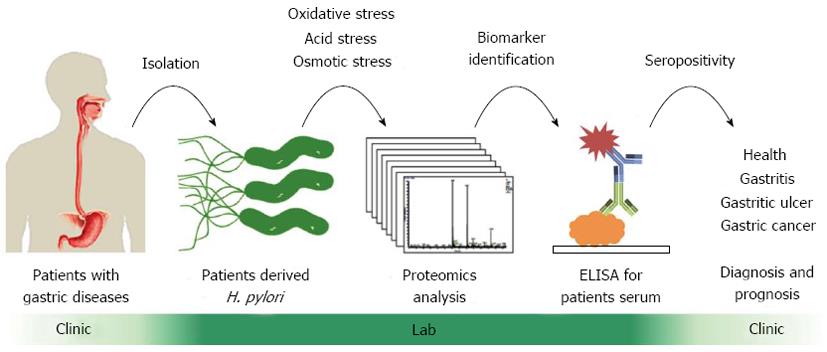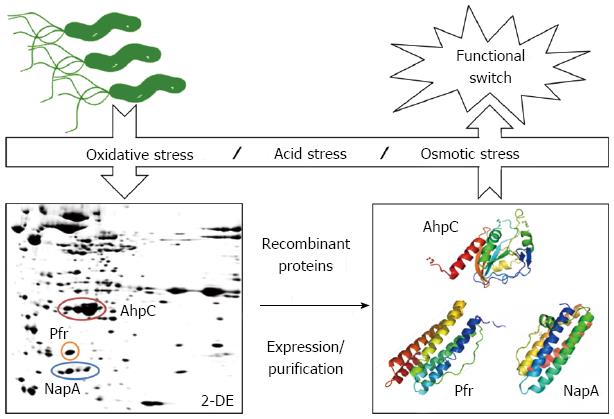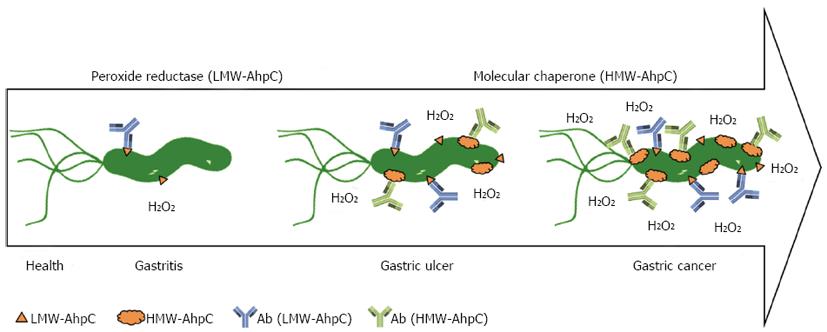Copyright
©2014 Baishideng Publishing Group Co.
World J Gastroenterol. Feb 14, 2014; 20(6): 1529-1536
Published online Feb 14, 2014. doi: 10.3748/wjg.v20.i6.1529
Published online Feb 14, 2014. doi: 10.3748/wjg.v20.i6.1529
Figure 1 Diagram of Helicobacter pylori exposed to various environmental stresses in stomach and intestine.
The development of gastrointestinal diseases is suggested to be associated with Helicobacter pylori (H. pylori) infection and environmental stresses in stomach and intestine. These stresses, such as oxidative, acid and osmotic stresses[33-36], may bring detrimental effects on H. pylori.
Figure 2 Flow chart of clinical proteomics platform designed for discovery and validation of Helicobacter pylori biomarkers for the diagnosis of gastrointestinal diseases.
We have set up a proteomics-based platform[32] to systematically identify and validate potential biomarkers in Helicobacter pylori (H. pylori) for gastrointestinal diseases, which can provide a major methodological support for translational medicine encompassing basic biomedical research and clinical therapeutic medicine. ELISA: Enzyme-linked immunosorbent assay.
Figure 3 Functional switch of identified Helicobacter pylori biomarkers in response to environmental stresses.
Alkylhydroperoxide reductase (AhpC), neutrophil-activating protein (NapA) and non-heme iron-binding ferritin (Pfr) are identified by clinical proteomics as potential biomarkers under different environmental stresses. Further biochemical characterization showed the protein structure change was accompanied by functional switch of these proteins under varied environmental conditions, such as oxidative, acid and osmotic stresses[34,36,38]. The PDB ID of Helicobacter pylori (H. pylori) AhpC, NapA and Pfr are 1ZOF[61], 1JI4[62] and 3EGM[63], respectively.
Figure 4 Alkylhydroperoxide reductase of Helicobacter pylori, a biomarker used to monitor different stages of inflammation associated with gastrointestinal diseases.
In cases of Helicobacter pylori (H. pylori) infection, none or low titers of serum antibody against low-molecular-weight (LMW)-alkylhydroperoxide reductase (AhpC) were detected in patients of gastritis with weak inflammation. However, higher titers of antibodies against high-molecular-weight (HMW)-AhpC were found in gastric ulcer and cancer patients with severe inflammation. Therefore, H. pylori AhpC can signal and monitor different stages of inflammation associated with H. pylori infection in gastrointestinal diseases[37].
-
Citation: Huang CH, Chiou SH. Clinical proteomics identifies potential biomarkers in
Helicobacter pylori for gastrointestinal diseases. World J Gastroenterol 2014; 20(6): 1529-1536 - URL: https://www.wjgnet.com/1007-9327/full/v20/i6/1529.htm
- DOI: https://dx.doi.org/10.3748/wjg.v20.i6.1529












